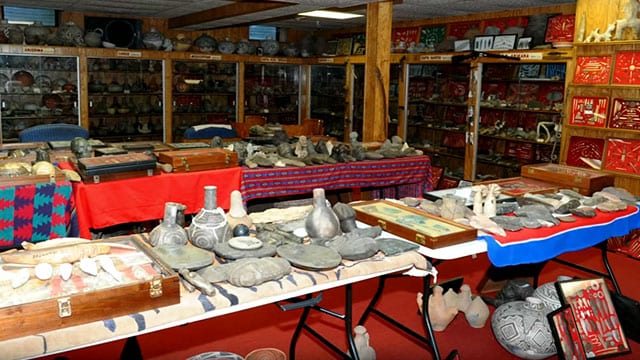
The Federal Bureau of Investigation (FBI) is calling on Indigenous communities in the United States to help them with a monumental task: Identifying and repatriating thousands of human remains and artifacts collected over a 60-year period.
It’s part of a four-year investigation into the recovery of 42,000 artifacts found in Don Miller’s Indiana farmhouse back in 2013 – one of the largest cases involving cultural artifacts the FBI has ever handled.
“The guy was not a professional archaeologist in any way,” said Pete Coffey, a compliance officer at the Tribal Historic Preservation Office in New Town, North Dakota.
“He had a lot of these bones in boxes with marker written on the side of it.”
Coffey is just one tribal member the FBI is working with.
Of those 42,000 artifacts, items range from different time periods and from different cultural traditions. There were also several thousand individual remains, representing more than 500 individuals, including full skeletons.
A majority of these human remains were of Native American ancestry, police say.
Miller was a Christian missionary who crossed the line between collecting artifacts and illegal activity, said Tim Carpenter, a special agent with the FBI’s Art Crime Team, who has been leading the investigation since 2014.
The FBI believes the human remains and artifacts were dug up from tribal burial grounds.
The farmhouse was filled with thousands of items. (FBI photo)
Miller initially signed over 7,000 items to the FBI in 2015, that are believed to have been obtained illegally.
Carpenter noted at that time Miller, who was 91 when he died in 2015, was co-operative and had a desire to repatriate the remains back to their rightful owners.
“The guy’s house was literally a museum. He had these huge display cases and fully articulated skeletons laying in these display cases in his living room,” said Coffey.
“He then dressed these skeletons in the grave goods that he had robbed. These skeletons had bone chokers on, breastplates and armbands that he had stolen from the graves.”
If Miller was missing bones to make up a full skeleton, Coffey said he would use bones from other remains.
And the missionary didn’t stop there.
“He took a skull, and cut the crown of that skull off and he had it on his coffee table as a fruit bowl and he had fruit in that skull,” said Coffey.
Despite the Native American Graves Protection and Repatriation Act, Coffey believes people like Miller are getting away with these types of activities.
Carpenter said they have to do osteological examinations on the remains and conduct extensive consultation with tribes.
Currently the artifacts are sitting in a nondescript warehouse in Indianapolis until they are claimed.

FBI Special Agent Tim Carpenter. (FBI photo)
The FBI reached out to 573 federally recognized tribes in the U.S to let them know about this case. Informal contact was also made with several non-recognized or state-recognized tribes. They also reached out to anthropologists and archaeologists, including graduate students.
Holly Cusack-McVeigh, an associate professor of anthropology and museum studies at Indiana University-Purdue University Indianapolis, is another person working with the FBI.
“So far there were a dozen ancestors who went back home to their people and were repatriated,” said Cusack-McVeigh.
This repatriation included representatives from many of the Sioux Tribe of South Dakota and three affiliated tribes of North Dakota, Cusack-McVeigh added.
Watch Todd Lamirande’s APTN Investigates episode: Extinction Event
To date there is no evidence that any of the human remains are from Canada.
Coffey said besides the artifacts recovered from Miller’s house, there are outstanding ones his nation is hoping to collect.
“There’s a museum in Stockholm that’s got an Arikara skull over there,” said Coffey of the North Dakota tribe.
Human remains and artifacts in faraway places is far too common.
As of late, the National Museums Scotland recently granted Canada the authority to take back two Beothuk skulls that have been at the museum for close to 170 years.
As APTN News has reported the federal government, the Canadian Museum of History, the province of Newfoundland and Labrador, and five Indigenous nations all made a formal request in November 2017 to National Museums Scotland to repatriate the remains back to Canada.

Close-up shot of two items recovered in Indiana. (FBI photo)
The two skulls are of Nonosabasut and Demasduit, a husband and wife that came from Red Indian Lake in central Newfoundland and Labrador.
The remains are expected to be in Canada sometime later this year.
The Beothuk are not alone in having their remains held in an institution.
In 2017, APTN Investigates reported that hundreds of human remains – ranging from small bone fragments to complete skeletons, and some from as far back as the ninth century – are held at universities across Canada.
Many of those human remains have been with universities since the 1920s and are stored in plastic bins, wooden trays or cardboard boxes.
Meanwhile, Native American tribes can email for more information on the FBI’s case.











Individuals who are collecting ancestor remains for private display, should be legally held accountable and tried in the same category as murderers or at least kidnapers, as they are continually killing and/or restraining the spirit after the bodies death, denying its journey to be with the ancestors in peace. And the museums who house remains for undue periods of time should be equated to morgues or prisons. Language needs to shift to better identify the purpose of spaces for showcasing history, and what/whose history is being told, and who is doing the telling!!! The barbarism of the colinizers needs to be held accountable!